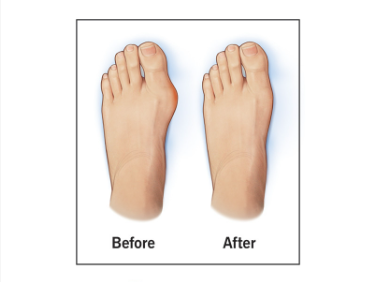Recovery from Bunion Surgery Patients who value both mobility and quality of life are becoming increasingly interested in time. Lived experiences show a range that varies depending on the surgical technique, post-operative care, and a person’s overall health profile, whereas medical literature provides unambiguous averages. Those who anticipate a rapid recovery frequently discover that success is measured in the gradual transition from immobility to confident movement rather than in days.
Almost all of the attention is directed toward controlling swelling and safeguarding the repair in the initial days following surgery. In addition to being advised, elevating the foot is essential for a speedy recovery. When compared to patients who are less disciplined, patients who follow this advice—along with regular icing and compression when necessary—often experience noticeably less swelling and discomfort. Preserving soft tissue and fragile bone structure from needless stress is the goal at this point.
Key Recovery Details for Bunion Surgery
| Detail | Information |
|---|---|
| Procedure Name | Bunionectomy / Bunion Correction Surgery |
| Primary Goal | Remove bunion and restore natural toe alignment |
| Typical Recovery Range | 6 to 12 weeks for core healing; up to 6 months for complete recovery |
| Weight-Bearing Milestones | Partial after ~2 weeks, full by 6–8 weeks (varies by patient and procedure) |
| Return to Normal Footwear | Usually 8–12 weeks post-surgery |
| Influencing Factors | Surgical method, age, bone healing speed, patient discipline in aftercare |
| Potential Risks | Infection, recurrence, nerve injury, delayed bone healing |
| Best Candidates | Patients with persistent pain unresponsive to non-surgical treatment |
| Reference |
The first real feeling of freedom is experienced during the partial weight-bearing stage. This can occur as early as two weeks for minimally invasive bunionectomy techniques or closer to six weeks for more intricate reconstructions such as the Lapidus procedure, depending on the type of bunionectomy. During this stage, patients can resume short walks while avoiding abrupt or uneven pressure on the healing joint because the protective boot serves as both a safety measure and a passport to limited mobility. It was like “teaching a child to walk on ice—every step deliberate, every move measured,” according to one seasoned podiatrist.
Many patients return to wearing regular shoes around eight to twelve weeks, preferably ones with soft, supportive cushioning and a wide toe box. For people who have been forced to wear post-operative boots, this milestone has emotional significance because it represents not only physical recovery but also a return to social normalcy and personal style. The journey is far from over, though, as mild discomfort, stiffness, and low-level swelling can last for months, especially after extended periods of standing.
The public’s expectations regarding the recovery from bunion surgery have been subtly altered by prominent figures in sports and entertainment. A few well-known athletes have shared their recovery stories, highlighting rigorous physical therapy as a highly successful strategy for regaining agility and avoiding scar tissue from impairing movement. Their message is unambiguous: the patient and care team must work together actively to recover; it is not a passive process.
The function of physical therapy goes beyond simple exercise. It consists of precisely timed mobility exercises, exercises to strengthen the intrinsic foot muscles, and balance training to guarantee stability on a variety of surfaces. Aquatic therapy has proven especially helpful for many patients, enabling them to exercise without the full weight-bearing demands that could otherwise put stress on healing tissue.
Psychological preparedness is yet another subtle but important component. It can be emotionally taxing to go from having chronic bunion pain to managing limitations following surgery. Relief is provided by early improvements, such as the lack of pain prior to surgery, but the patience needed to restore full function may test resolve. People who have robust support networks tend to be more upbeat, which is associated with more seamless recovery.
Significant advancements in surgical technique have been made in the last ten years. For some patients, minimally invasive bunion correction techniques that use specialized tools and smaller incisions have proven to be very effective in shortening recovery times. Although they aren’t appropriate in every situation, they have shown a remarkable ability to help younger and more active patients resume their routines earlier without sacrificing long-term stability.
In the end, recovery from bunion surgery depends as much on attitude as on treatment. Patients who approach healing with the same commitment they would make to training for a significant physical challenge—following directions exactly, participating in guided rehabilitation, and giving their bodies the time they need—usually have the best results.
More patients in their 30s and 40s are choosing surgery over years of discomfort, indicating a trend toward earlier intervention, according to podiatrists. This illustrates how active living and preventative care are valued in society at large. Future patients should expect a significantly better average recovery experience as surgical techniques continue to advance and patient education becomes more widely available.

